fuel type CHEVROLET ASTRO 1997 2.G Owners Manual
[x] Cancel search | Manufacturer: CHEVROLET, Model Year: 1997, Model line: ASTRO, Model: CHEVROLET ASTRO 1997 2.GPages: 404, PDF Size: 20.63 MB
Page 259 of 404
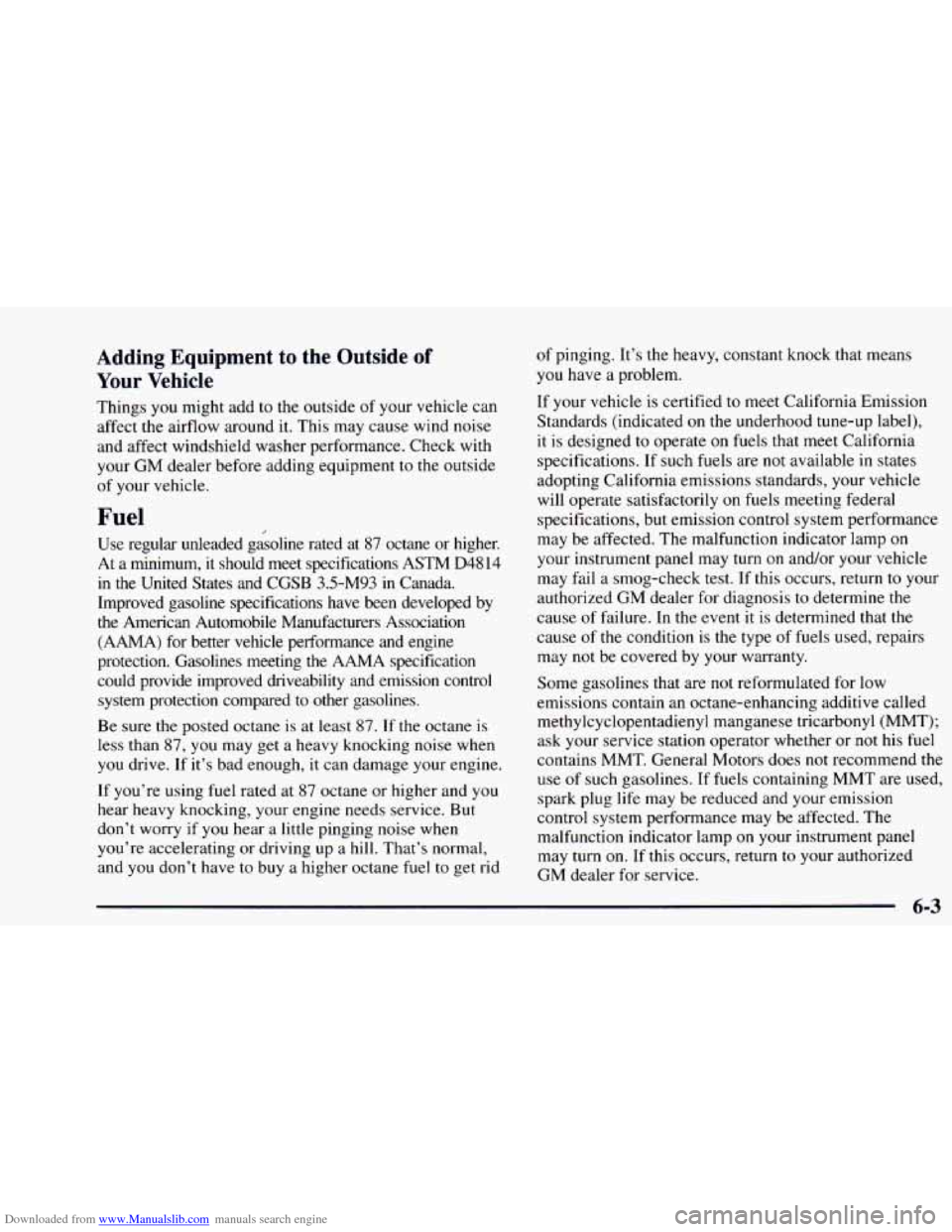
Downloaded from www.Manualslib.com manuals search engine Adding Equipment to the Outside of
Your Vehicle
Things you might add to the outside of your vehicle can
affect the airflow around it. This may cause wind noise
and affect windshield washer performance. Check with
your GM dealer before adding equipment
to the outside
of your vehicle.
J
Use regular unleaded gasoline rated at 87 octane or higher.
At a minimum, it should meet specifications ASTM
D48 14
in the United States and CGSB 3.5-M93 in Canada.
Improved gasoline specifications have been developed by
the American Automobile Manufacturers Association (AAMA) for better vehicle performance and engine
protection. Gasolines meeting the AAMA specification
could provide improved driveability and emission control
system protection compared to other gasolines.
Be sure the posted octane is at least 87. If the octane
is
less than 87, you may get a heavy knocking noise when
you drive. If it’s bad enough, it can damage your engine.
If you’re using fuel rated at 87 octane or higher and you
hear heavy knocking, your engine needs service. But
don’t worry if
you hear a little pinging noise when
you’re accelerating or driving up a hill. That’s normal,
and you don’t have to buy a higher octane fuel to get rid
of pinging. It’s the heavy, constant knock that means
you have a problem.
If your vehicle is certified to meet California Emission
Standards (indicated on the underhood tune-up label),
it is designed to operate
on fuels that meet California
specifications. If such fuels are
not available in states
adopting California emissions standards, your vehicle
will operate satisfactorily on fuels meeting federal
specifications, but emission control system performance
may be affected. The malfunction indicator lamp on
your instrument panel may turn on and/or your vehicle
may fail a smog-check test. If this occurs, return to your
authorized GM dealer for diagnosis to determine the
cause
of failure. In the event it is determined that the
cause of the condition is the type of fuels used, repairs
may not be covered by your warranty.
Some gasolines that are not reformulated for low
emissions contain an octane-enhancing additive called
methylcyclopentadienyl manganese tricarbonyl (MMT);
ask your service station operator whether or not his fuel
contains MMT. General Motors does
not recommend the
use of such gasolines. If fuels containing MMT are used,
spark plug
life may be reduced and your emission
control system performance may be affected.
The
malfunction indicator lamp on your instrument panel
may turn
on. If this occurs, return to your authorized
GM dealer for service.
6-3
Page 263 of 404
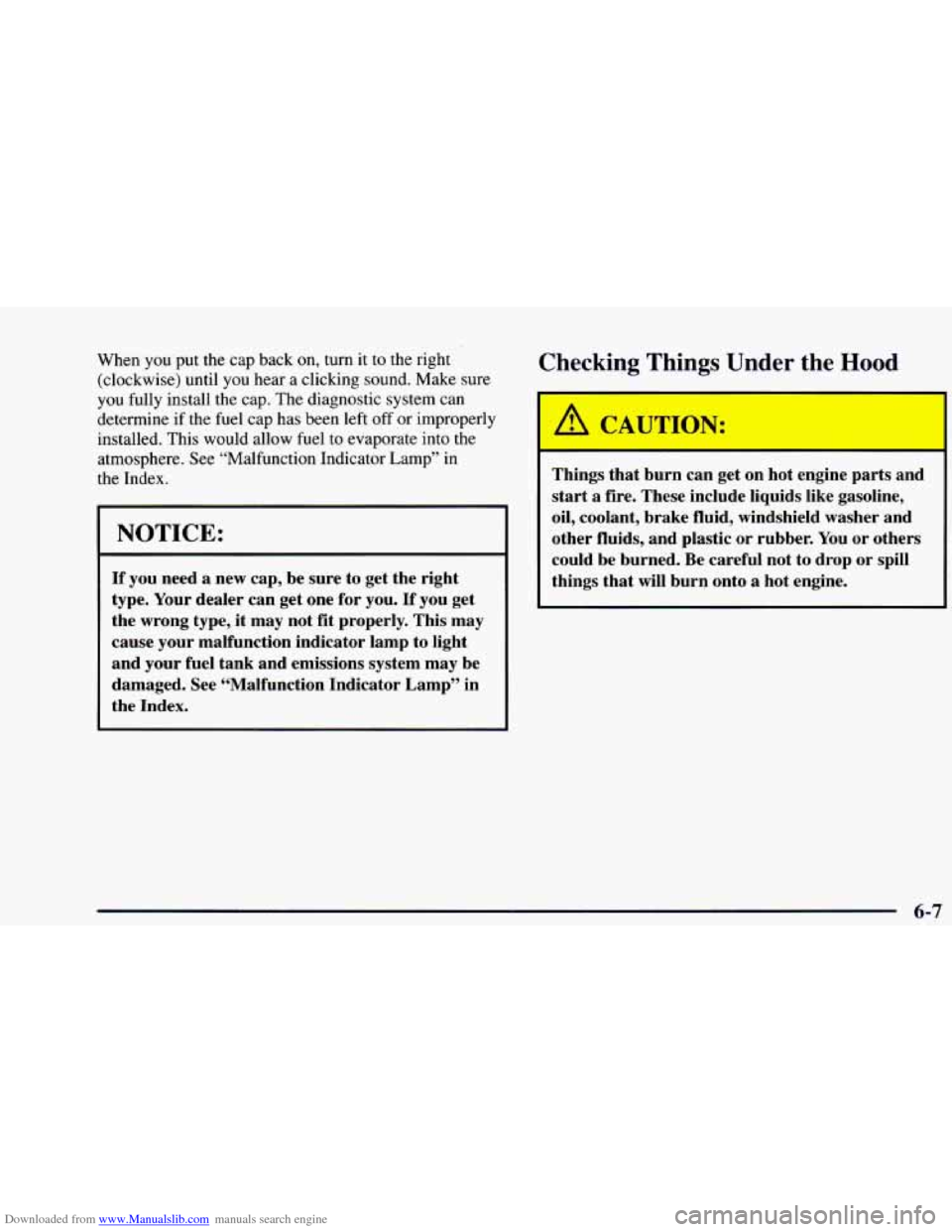
Downloaded from www.Manualslib.com manuals search engine When you put the cap back on, turn it to the right
(clockwise) until
you hear a clicking sound. Make sure
you fully install the cap. The diagnostic system can
determine if the fuel cap has been left off or improperly
installed. This would allow fuel to evaporate into the
atmosphere. See “Malfunction Indicator Lamp” in
the Index.
NOTICE:
If you need a new cap, be sure to get the right
type. Your dealer can get one for you.
If you get
the wrong type,
it may not fit properly. This may
cause your malfunction indicator lamp to light
and your fuel tank and emissions system may be
damaged. See “Malfunction Indicator Lamp” in
the Index.
Checking Things Under the Hoc4
m-
Things that burn can get on hot engine parts and
start a fire. These include liquids like gasoline,
oil, coolant, brake fluid, windshield washer and
other fluids, and plastic or rubber. You
or others
could be burned. Be careful not to drop or spill
things that will burn onto a hot engine.
6-7
Page 300 of 404
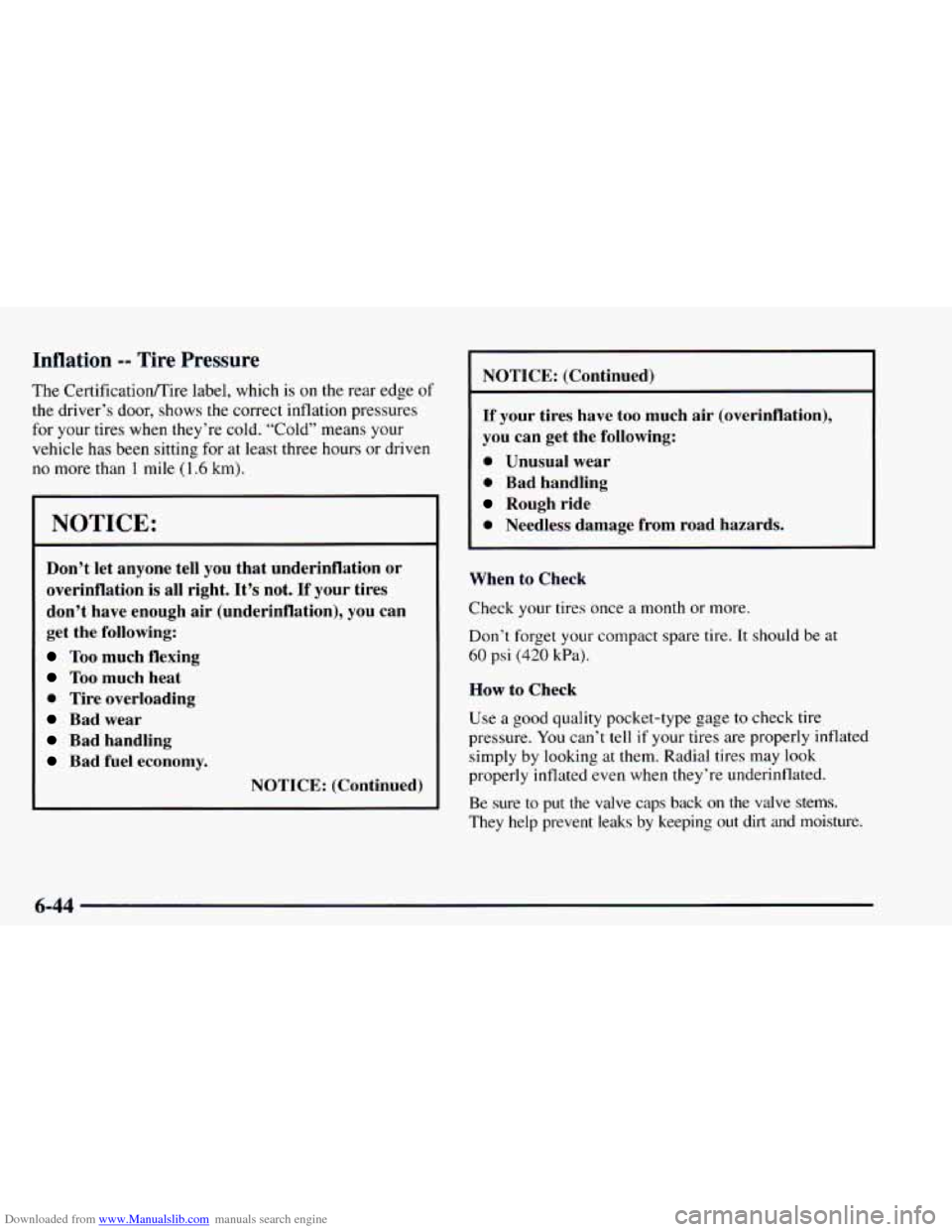
Downloaded from www.Manualslib.com manuals search engine Inflation -- Tire Pressure
The CertificationRire label, which is on the rear edge of
the driver’s door, shows the correct inflation pressures
for your
tires when they’re cold. “Cold” means your
vehicle has been sitting for at least three hours or driven
no more than
1 mile (1.6 km).
NOTICE:
Don’t let anyone tell you that underinflation or
overinflation is all right.
It’s not. If your tires
don’t have enough
air (underinflation), you can
get the following:
Too much flexing
Too much heat
0 Tire overloading
Bad wear
Bad handling
Bad fuel economy.
NOTICE: (Continued) NOTICE: (Continued)
If your tires have too much air
(overinflation),
you can get the following:
0 Unusual wear
0 Bad handling
Rough ride
0 Needless damage from road hazards.
When
to Check
Check your tires once a month or more.
Don’t forget your compact spare tire.
It should be at
60 psi (420 kPa).
How to Check
use a
good quality pocket-type gage to check tire
pressure.
You can’t tell if your tires are properly inflated
simply by looking at them. Radial tires may look
properly inflated even when they’re underinflated.
Be sure to put the valve caps back
on the valve stems.
They help prevent leaks by keeping
out dirt and moisture.
6-44
Page 323 of 404
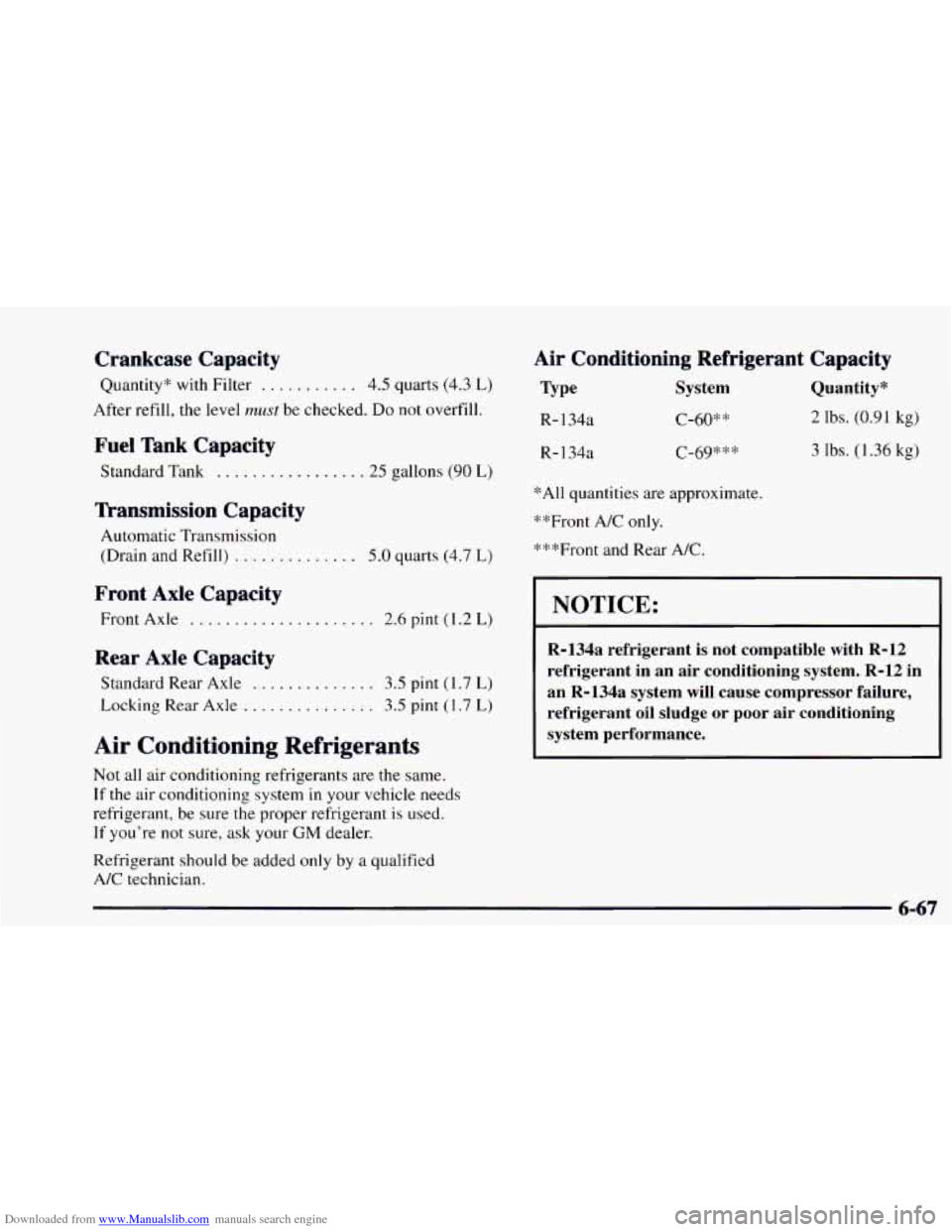
Downloaded from www.Manualslib.com manuals search engine Crankcase Capacity
Quantity* with Filter ........... 4.5 quarts (4.3 L)
After refill, the level must be checked. Do not overfill.
Fuel Tank Capacity
Standard Tank ................. 25 gallons (90 L)
Transmission Capacity
Automatic Transmission
(Drain and Refill)
.......... 5.0 quarts (4.7 L)
Front Axle Capacity
Front Axle .............. ... 2.6 pint (1.2 L)
Rear Axle Capacity
Standard Rear Axle .............. 3.5 pint (1.7 L)
Locking Rear Axle ............... 3.5 pint (1.7 L)
Air Conditioning Refrigerants
Not all air conditioning refrigerants are the same.
If the air conditioning system in your vehicle needs
refrigerant, be sure
the proper refrigerant is used.
If you’re not sure,
ask your GM dealer.
Refrigerant should be added only by a qualified
A/C technician.
Air Conditioning Refrigerant Capacity
Type System Quantity*
R- 134a C-60** 2 Ibs. (0.91 kg)
R- 134a C-(j9*** 3 lbs. (1.36 kg)
*All quantities are approximate.
**Front A/C only.
***Front and Rear A/C.
I NOTICE:
I
R-134a refrigerant is not compatible with R-12
refrigerant in an air conditioning system. R-12 in
an R-134a system
will cause compressor failure,
refrigerant oil sludge or poor air conditioning
system performance.
6-67
Page 324 of 404
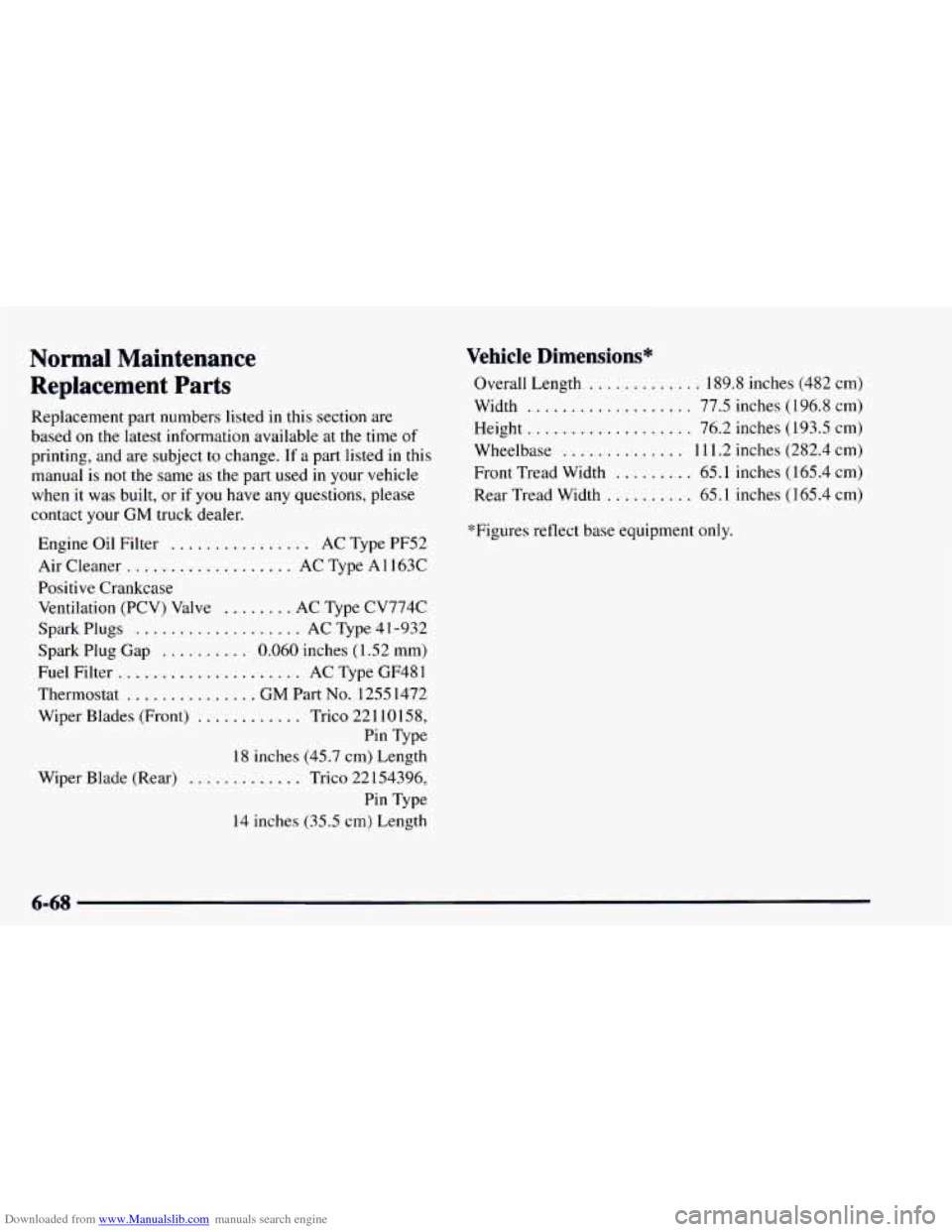
Downloaded from www.Manualslib.com manuals search engine Normal Maintenance
Replacement Parts
Replacement part numbers listed in this section are
based
on the latest information available at the time of
printing, and are subject to change. If a part listed in this
manual
is not the same as the part used in your vehicle
when it was built, or if you have any questions, please
contact your
GM truck dealer.
Engine Oil Filter
................ AC Type PF52
Air Cleaner
................... AC Type A 1 163C
Positive Crankcase
Ventilation (PCV) Valve
........ AC Type CV774C
Spark Plugs
................... AC Type 4 1-932
Spark Plug Gap
.......... 0.060 inches ( 1.52 mm)
Fuel Filter ..................... AC Type GF48 1
Thermostat
............... GM Part No. 1255 1472
Wiper Blades (Front)
............ Trico 221 10158, Pin Type
18 inches (45.7 cm) Length
Wiper Blade (Rear)
............. Trico 22 154396,
Pin Type
14 inches (35.5 cm) Length
Vehicle Dimensions*
Overall Length ............. 189.8 inches (482 cm)
Width
................... 77.5 inches (196.8 cm)
Height.
.................. 76.2 inches (193.5 cm)
Wheelbase
.............. 1 1 1.2 inches (282.4 cm)
Front Tread Width
......... 65.1 inches (165.4 cm)
Rear Tread Width
.......... 65.1 inches ( 1 65.4 cm)
*Figures reflect base equipment
only.
6-68